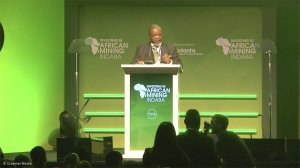Mineral Resources and Energy Minister Gwede Mantashe has assured mining companies in South Africa they will be able to generate their own energy to counter severe energy constraints.
He also on Monday announced that government would be talking to investors about establishing a generating company outside of Eskom.
Mantashe told delegates at the Investing in African Mining Indaba, in Cape Town, that he was concerned by data released by Statistics South Africa in November that showed a 3.1% year-on-year decrease in mining production.
“This reality forced us to take serious decisions. That is why we have agreed that because of the problems of energy, we must allow our mining companies to generate energy for self-use. You will not need a licence for that. You just need to be registered for that and you can run ahead,” Mantashe said to applause from the delegates during the opening plenary.
“Secondly, we have taken a decision that we will talk to investors about starting a generating company outside of Eskom. This is a security measure, so that as Eskom grapples with the crisis, and the problems, we must have a failsafe option of providing energy.” He said this was particularly important, with "the pressure" to close to number of coal-fired power stations.
“We must start generating energy and ensure we go back to the comfortable days when we had a surplus of energy.”
He said the price of energy was one of the major problems facing the country.
“If electricity is expensive, the economy is de-industrialising.”
Mantashe said although platinum group metals (PGMs), coal and iron-ore contributed most to the decline in production last year, non-metallic minerals made significant positive contribution to production.
“Average prices for most commodities are expected to remain relatively flat or have marginal growth in 2020 and beyond. This will provide a better basis for most mining projects in the coming years.”
Mantashe said the government had noted “with concern” the recent announcements for planned retrenchments as high unemployment was a threat to the economy.
“The 2018/19 Annual Report of the Council for Conciliation, Mediation and Arbitration highlights Section 189 retrenchments in the mining sector as the second-largest contributor of job losses after the construction sector. Stakeholders and social partners and the department must dialogue to find ways [to mitigate] against job losses.”
The Minister said one of the department’s priorities was to provide more policy and regulatory certainty, as this was key to attracting investors.
“The more we engage with the investor sector, the better the regulatory framework.”
Mantashe said the government also wanted to see more exploration taking place.
“The intention is to grow the national target from below 5% to respectable levels within the next few years.”
He said the government had invested in the integrated and multidisciplinary geoscience mapping programme.
“Early results are uncovering previously undefined geological features that may host significant mineral wealth. For example, recently defined extensions of greenstone belts that may host hydrothermal mineral deposits and alkaline complexes. These may yet prove to host rare earth elements and other critical mineral resources.”
Mantashe said one of the challenges that was putting pressure on Eskom was using diesel as a peak source of energy. He said the intention was to replace diesel use with hydrogen fuel cell technology.
“Together with Anglo Platinum, the department, through our agency Mintek, is working on using hydro-fuel cells as an energy source for the mining trucks. The intention is to replace diesel usage with hydro-fuel cell technology. This is a major and innovative project that will have a significant impact on low carbon emissions.”
The Minister also called on mining companies to take seriously the communities on whose land they mine.
“It is important to see communities as partners rather than enemies, because if they protect your mining operations they feel as if it belongs to them…but if treated as foreign agents in the mining communities, then this will create lots of problems, with disruptions.”
Mantashe said he was pleased with the drop in fatalities in the mining sector in 2019.
“The health and safety of employees is a key priority. Together we made significant progress in 2019, reducing fatalities from 81 in 2018 to 51 in 2019. This is a record low and evidence that a fatality-free mining industry is possible. We must redouble our efforts to reach our goal of zero harm.”
Edited by: Creamer Media Reporter
EMAIL THIS ARTICLE SAVE THIS ARTICLE
ARTICLE ENQUIRY
To subscribe email subscriptions@creamermedia.co.za or click here
To advertise email advertising@creamermedia.co.za or click here












